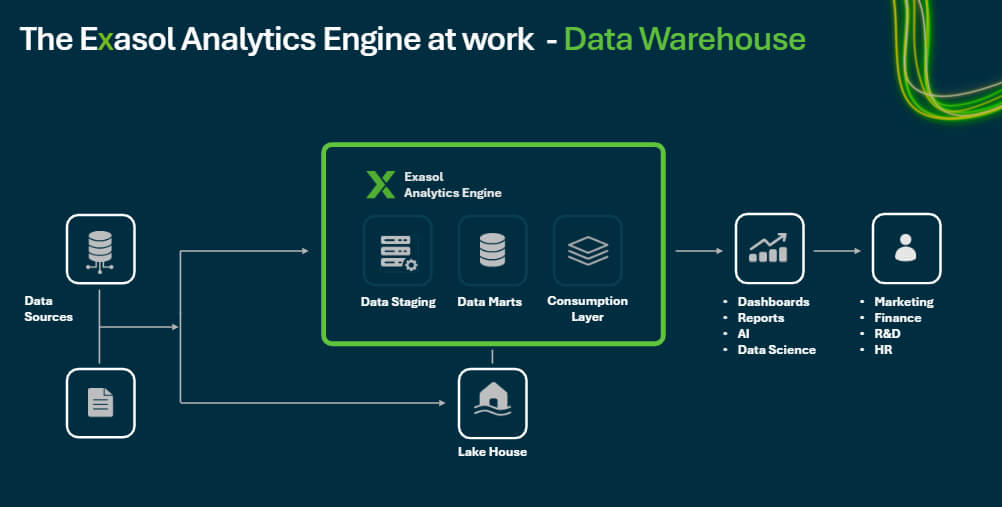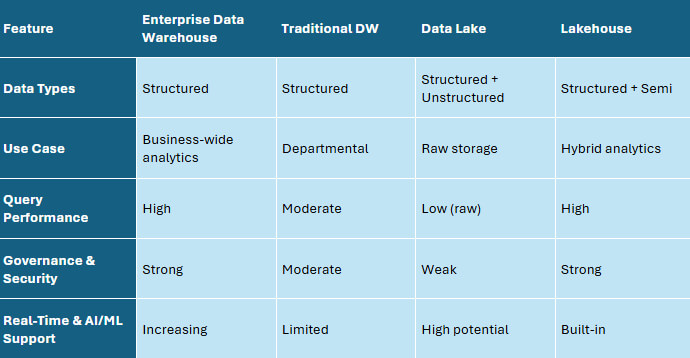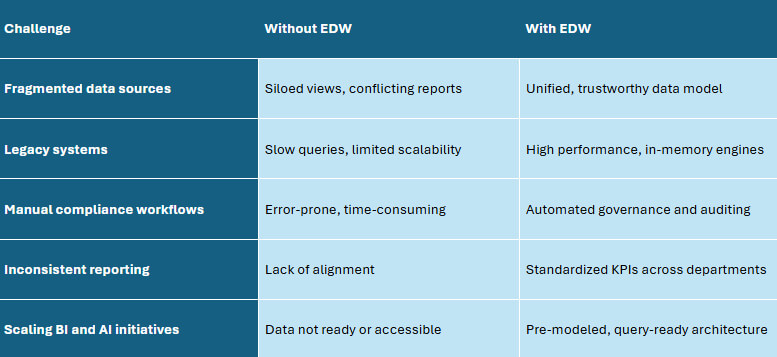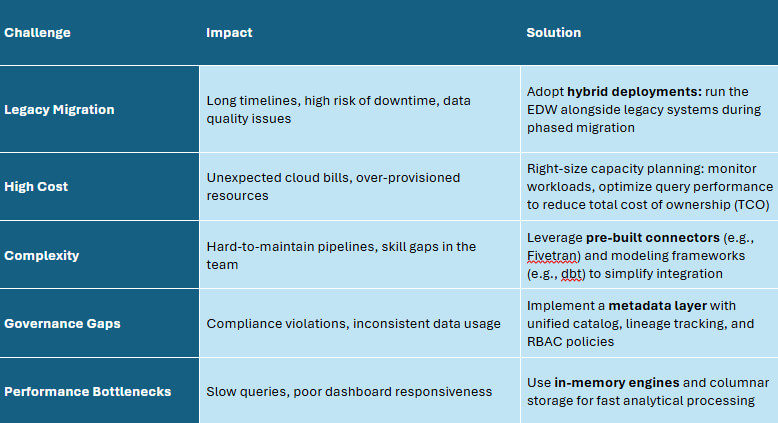
What Is an Enterprise Data Warehouse?

An Enterprise Data Warehouse (EDW) is a centralized system that stores, manages, and analyzes structured data across an entire organization. Unlike basic data warehouses built for specific departments, an EDW integrates data from multiple sources—finance, marketing, operations, and more—into a single source of truth for decision-making.
It’s designed to handle large-scale, complex data workloads, supporting real-time queries, historical trend analysis, and compliance-driven reporting needs across the business, traits central to the modern data warehouse.

Here’s a high-level view of how a modern Enterprise Data Warehouse works — we’ll unpack each layer in the sections below.
Key Characteristics of an EDW:
- Centralized: Brings together data from all departments.
- Structured: Optimized for clean, relational data models.
- Governed: Enables fine-grained control over access and compliance.
- Scalable: Handles growing data volumes and user demand.
- Query-Optimized: Built for fast analytics and BI tooling.
If you’re new to the fundamentals, it helps to start with the core data warehouse concepts and basics before diving into enterprise-level capabilities.
In the next section, we’ll quickly cover the key differences between different technologies.
EDW vs Traditional Data Warehouse vs Data Lake vs Lakehouse

For an in-depth overview, you can explore our article on data lake vs data warehouse as many organizations consider hybrid strategies.
Why EDW Still Matters in 2025
Despite the rise of lakehouses and real-time pipelines, EDWs remain critical for:
- Compliance-heavy industries (e.g., finance, healthcare)
- Legacy system integration
- Business-critical reporting
- Enterprise-wide data strategy
The modern EDW has evolved — it’s no longer just a static reporting database. Today’s EDW is flexible, cloud-enabled, and AI-ready, helping enterprises move faster while staying in control.
For governance, consistency, and performance benefits, see our in-depth guide on data warehouse advantages.
Why Do Enterprises Need a Data Warehouse?
Research And Markets forecasts that the EDW market will expand from $14.0 billion in 2023 to $71.5 billion by 2030 (CAGR: 26.3%), as enterprises invest in scalable, governed analytics platforms, reinforcing the urgency of modern EDW deployments.
Business Research Insights projects similar momentum, estimating growth from $3.01 billion in 2024 to $18.67 billion by 2033 at a 22.8% CAGR (source), underscoring the sustained long-term demand for EDW solutions.
Modern enterprises generate massive volumes of data—from operations, customer interactions, transactions, and external systems. Without a unified platform to store, process, and analyze this data, it becomes fragmented, inconsistent, and underused. Established platforms such as SQL Data Warehouse in SQL Server
illustrate how mature systems address these challenges.
An Enterprise Data Warehouse (EDW) brings it all together—offering a single source of truth that fuels real-time decisions, cross-departmental reporting, and AI-powered insights.

Try Exasol Free: No Costs, Just Speed
Run Exasol locally and test real workloads at full speed.
Key Drivers for EDW Adoption
Unified View of the Business
Break down silos and gain cross-functional visibility—marketing, finance, operations, and product teams working from the same data.
Performance at Scale
Handle billions of records with high-speed querying, even as data and user demand grow.
Compliance and Governance
Meet regulatory demands (GDPR, HIPAA, SOX) with secure access control, lineage tracking, and audit trails.
Real-Time Insights
Support time-sensitive decisions with low-latency ingestion and query execution, ideal for dashboards and alerts.
Deployment Flexibility
Deploy where you need—on-premises, hybrid, or cloud—with the ability to scale on demand.
Common Enterprise Pain Points Solved by EDWs

Decisions need to be data-driven, fast, and accountable. An Enterprise Data Warehouse makes that possible — not by just storing data, but by making it usable, governed, and available at the speed of business.
Alexander Stigsen, Chief Product Officer, Exasol
Enterprise Data Warehouse Architecture (Overview)
An EDW typically spans three layers—Data Staging, Integration, and Presentation—supported by metadata and governance.
For a deeper technical breakdown and design patterns, see our full data warehouse architecture guide.
Key Components of an Enterprise Data Warehouse
A modern Enterprise Data Warehouse is more than just storage — it’s a set of integrated layers that work together to deliver reliable, governed, and ready-to-use data.
The initial process of building a data warehouse typically involves setting clear business goals, defining architecture, and planning data flows.
Here’s how each layer functions.
Data Integration Layer
Purpose: Bring together data from multiple internal and external sources into the EDW.
Processes:
- ETL (Extract, Transform, Load): Transform data before loading it into the warehouse — ideal for structured, stable data pipelines.
- ELT (Extract, Load, Transform): Load raw data first, transform on demand — more flexible for modern, cloud-based workloads.
- Change Data Capture (CDC): Sync only updated records for near real-time accuracy.
Data Modeling Layer
Purpose: Organize data into efficient, logical structures for analytics.
Common Models:
- Star Schema: Simplifies querying with a central fact table linked to dimensions.
- Snowflake Schema: Normalizes dimensions for space savings and consistency.
- Data Vault: Flexible, scalable modeling for complex, evolving data.
These fall under the framework of data warehouse models that guide schema choices.
OLAP vs OLTP:
- OLAP (Online Analytical Processing): For aggregated, analytical queries.
- OLTP (Online Transaction Processing): For operational, transactional systems (usually EDW integrates OLTP data, not hosts it).
Governance Layer
Purpose: Ensure security, compliance, and trust in enterprise data.
Key Functions:
- Role-Based Access Control (RBAC): Restrict access by user role or department.
- Data Lineage: Track data origin and transformation history.
- Cataloging & Metadata Management: Organize and describe datasets for easy discovery.
- Regulatory Compliance: GDPR, HIPAA, SOX, and other jurisdiction-specific standards.
Presentation & Query Layer
Purpose: Deliver data to end-users and systems in a usable format.
Capabilities:
- SQL Access: Standard query language for BI tools, analysts, and data scientists.
- BI Tool Integration: Power BI, Tableau, Looker, Qlik.
- Embedded AI/ML: Directly run models within the EDW environment (e.g., Exasol + Veezoo).
- APIs & Connectors: Allow applications and microservices to query the EDW programmatically.

Try Exasol Free: No Costs, Just Speed
Run Exasol locally and test real workloads at full speed.
Modern Trends in EDW (2025+)
Enterprise Data Warehousing is evolving fast. While the fundamentals remain — centralization, governance, and performance — the architecture and capabilities are adapting to meet new demands in analytics, AI, and real-time decision-making.
EDW + Lakehouse Hybrid Models
The lines between data warehouses, data lakes, and lakehouses are blurring.
Modern EDWs increasingly integrate with lakehouse platforms to:
- Store both structured and semi-structured data
- Support advanced analytics and AI workloads
- Reduce data duplication between systems
Example: Using an EDW for high-speed reporting while keeping raw, unstructured data in a connected lakehouse for exploration.
Real-Time Streaming Ingestion
Batch loading is no longer enough for many industries.
With streaming pipelines:
- Data from IoT devices, clickstreams, and transactions is available for querying within seconds
- Business-critical dashboards update continuously
- Use cases like fraud detection and supply chain optimization become viable
AI/ML-Ready Data Pipelines
EDWs are becoming AI-native:
- Store and serve training datasets directly from governed sources
- Provide feature stores for machine learning models
- Enable in-database model execution (e.g., Exasol data warehouse)
This reduces latency between data preparation and model deployment, allowing teams to operationalize AI faster.
Data Virtualization & Federated Queries
Not all data needs to live inside the EDW.
With virtualization:
- Analysts can query data where it resides — across multiple warehouses, lakes, and operational systems
- Reduces the need for costly and complex migrations
- Improves agility for enterprises with hybrid or multi-cloud architectures
Common Challenges (and Solutions)
Even the most advanced Enterprise Data Warehouses come with challenges. Recognizing these early helps organizations design architectures that are sustainable, cost-effective, and future-proof.

How to Choose the Right EDW Platform
Selecting an Enterprise Data Warehouse is a long-term decision — it impacts performance, compliance, and the ability to scale analytics across the organization. The right platform should balance speed, flexibility, governance, and cost efficiency.
Key Selection Criteria
Performance at Scale
- Can the platform handle large, complex datasets without query slowdowns?
- Does it support in-memory or columnar storage for analytical workloads?
Deployment Flexibility
- Does it support on-premises, private cloud, or hybrid models to match your infrastructure strategy?
- Can it integrate with existing BI and analytics tools without major rework?
Governance & Security
- Role-based access control, encryption, and data lineage tracking should be built-in.
- The platform should make it easy to meet industry compliance requirements (GDPR, HIPAA, SOX).
Integration & Connectivity
- How easily can it connect to data sources, APIs, and streaming platforms?
- Is it compatible with your ETL/ELT and orchestration tools?
Total Cost of Ownership (TCO)
- Beyond licensing, consider operational costs: hardware, maintenance, optimization needs, and skills required to run it effectively.
Questions to Ask Your Vendor
- What is the typical query performance for datasets of our size and complexity?
- Which deployment models do you support, and can we change later without re-platforming?
- How is security handled at rest, in transit, and during query execution?
- What’s the process for scaling storage and compute resources?
- How do you ensure compatibility with our current and future analytics stack?
- Can you provide benchmarks or customer examples in similar industries?
Comparison Table: Leading EDW Platforms
High-level view; features evolve over time — always verify with the vendor’s documentation.
| Snowflake | BigQuery | Exasol | Oracle | Redshift | |
|---|---|---|---|---|---|
| Deployment Options | Cloud | Cloud | On-prem, Cloud, Hybrid | On-prem, Cloud | Cloud |
| Performance Model | Cloud compute scaling | Distributed query engine | In-memory + MPP | MPP | MPP |
| Governance Features | RBAC, masking | RBAC | RBAC, encryption, lineage | RBAC, encryption | RBAC |
| Integration Strength | High | High | High | Medium | Medium |
| AI/ML Integration | Medium | High | Medium | Low | Low |
| Best For | Cloud-first orgs | Cloud-first + ML-heavy | Hybrid flexibility, high-speed analytics | Enterprise IT shops | AWS-native workloads |

Try Exasol Free: No Costs, Just Speed
Run Exasol locally and test real workloads at full speed.
Enterprise Data Warehouse Use Cases
1. Helsana (Healthcare Insurance – Switzerland)
The Challenge: A fragmented infrastructure with multiple tools and disparate systems led to slow dashboards, high maintenance costs, and poor agility.
Solution: Helsana consolidated onto a single, high-speed platform using Exasol, WhereScape (ETL), and MicroStrategy (reporting).
Results:
- 5–10× faster queries, significantly improving user experience and dashboard responsiveness.
- 65% reduction in licensing and maintenance costs in the first year.
- Built a foundation for AI‑powered analytics, enabling deeper insights and automation.
2. Gintarinė Vaistinė (Pharmacy & Wholesale – Lithuania / Baltics)
The Challenge: Slow query performance, lack of analytics capabilities, and inability to scale with growing data hindered insights and decision-making.
Solution: Implemented Exasol as the high-performance analytics platform across the enterprise.
Results:
- 10× faster query speeds, cutting complex query times from ~30 seconds to under 2 seconds.
- Delivered near real-time analytics, enhancing inventory management and customer segmentation.
- Enabled enterprise-wide operational visibility, fostering a data-driven culture across 240+ stores.
3. bank99 (Banking – Austria)
The Challenge: bank99 ran SAS (on Oracle) and Microsoft SQL Server in parallel. Consolidating two core banking systems was slow, with daily data loads taking up to six hours, limiting timely insights.
Solution: Migrated to Exasol in the Microsoft Azure cloud, using the RED Framework from Syncs IT and TV Visualizer. The move enabled a self-service BI approach, giving teams direct access to consolidated data.
Results:
- Cut daily data load time from 6 hours to ~10 minutes.
- Enabled DirectQuery in BI tools for always up-to-date data.
- Delivered near real-time reporting and improved adoption across the bank.
Check the video below and hear directly from bank 99’s Data Platform Owner:
Get Started with Enterprise Data Warehousing
A successful EDW initiative begins with a clear strategy, the right architecture, and a partner who understands both your technical and business needs.
Step 1 – Define Your Objectives
Clarify what success looks like: faster analytics, better compliance, real-time insights, or cost efficiency.
Step 2 – Assess Your Current Landscape
Map your data sources, integration pipelines, governance processes, and reporting tools to understand your starting point.
Step 3 – Select the Right Architecture
Choose deployment and integration models (on-premises, hybrid, or cloud-connected) that align with your operational and compliance requirements.
Step 4 – Pilot, Measure, Scale
Start with a high-impact use case, validate performance and governance, then expand across the enterprise.
Let’s build your next-generation EDW together.
Talk to an expert or request a demo.
Frequently Asked Questions
A data warehouse is a centralized repository for structured data, typically serving specific departments or use cases. An enterprise data warehouse (EDW) consolidates data across the entire organization, integrating multiple sources to create a single source of truth for analytics, reporting, and decision-making.
EDW stands for Enterprise Data Warehouse, a centralized system for enterprise-wide analytics.
DM stands for Data Mart, a smaller, subject-specific subset of the EDW, designed for departmental use (e.g., finance, marketing).
An Operational Data Store (ODS) is designed for real-time operational reporting and often contains current or near-current data. An EDW stores historical and current data optimized for analytical queries and strategic decision-making.
In SQL contexts, EDW refers to the enterprise data warehouse database schema or environment. SQL is used to query, transform, and manage the data within the EDW.